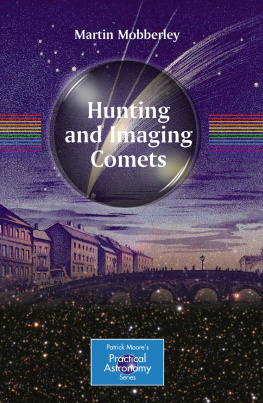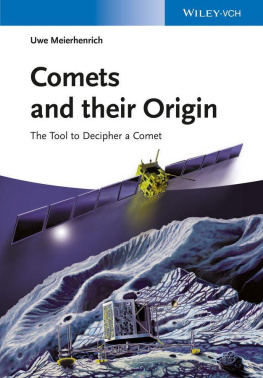Martin Mobberley Patrick Moore's Practical Astronomy Series Hunting and Imaging Comets 10.1007/978-1-4419-6905-7_1 Springer Science+Business Media, LLC 2011
1. Comets, Their Orbits, and Where They Hide!
Within the visible universe our solar system occupies a very local region of space. Sunlight reflected from the distant planet Neptune takes only 4 h to reach us here on Earth and yet we can also see quasars and gamma ray bursts whose light has taken up to 13 billion years to arrive. It may take our rockets a year or two to reach the planets but at least they can visit them within a time period that is short compared to our lifespan so we are seeing these objects in almost real time compared to everything else in the night sky. One added benefit of nearby objects is that they can drift against the background stars thereby adding an extra degree of reality and fascination to their study. Objects that move and change their appearance dramatically through a telescope are especially fascinating to us amateur astronomers. We all know that the Universe is a three dimensional place (and maybe even 11 dimensional if you are a string theorist!) but most of the time the objects in it look like they are fixed to a two dimensional star chart plastered on the sky a few miles above our heads. However, dramatic nearby phenomena are extra special and prove to us, if any proof where needed, that we are living in a solar system where absurdly large boulders orbit the Sun at incomprehensible speeds. Undoubtedly the most dramatic example of a rapidly changing spectacle in the sky is a total solar eclipse. Few who have seen one of these ultimate solar system alignments would dispute this; but unless you are on the narrow umbral track and have clear skies for those few minutes you will miss it!
A dramatic display of aurora or a true meteor storm, involving thousands of meteors per hour streaking through the sky, can have a similar effect on the observer too. There is one other category of object that can send shivers down the spine though and that is the appearance of a truly Great comet. During every century there are always a number of comets that, for a few days, weeks or even months can hold the general public spellbound as they gaze in amazement into the sky. The most awesome comets can have tails that span 60 or more, with heads bigger than the full Moon and they can perceptibly move against the starry backdrop of the constellations from night to night. Even for those people with no interest in astronomy, such a spectacle can hold their fascination as, suddenly, the Universe is three dimensional and they are standing on a small planet watching something enormous float through the inner solar system. Imagine if your name was attached to that comet, as its discoverer. Surely, it must be the biggest ego trip an astronomer can have!
The best comets can have tails that are millions, or even hundreds of millions, of kilometers long. They can, briefly, become the largest objects in the solar system, even if, in terms of mass they are relatively insignificant. The tails of comets are incredibly ghostly away from the head. It would not be a lie to say that the density of material in a comets tail is, by normal standards, as tenuous as a laboratory vacuum; but when illuminated by the Sun, against a dark sky, it is remarkable how well that gossamer thin material reflects the light. All the gas and dust that forms those two distinct tails in a comet originates from a region called the nucleus. Cometary nuclei are tiny by solar system standards. Even the nuclei of Great Comets can range from just 5 km in diameter to a massive 60 km in the case of a comet like HaleBopp. OK, you would not want either of those two objects landing in your backyard, but by planetary standards those dimensions are very small.
Comets have always held a great fascination for amateur astronomers and potential naked eye comets are always highly anticipated. In the twenty-first century, technology has moved on and keen amateurs can do really useful scientific research where comets are concerned. While the visual astronomer is still able to observe comets through the eyepiece in the traditional way, the CCD imager can easily go five magnitudes deeper and bring out details using image processing that no dark adapted eye can ever see. In addition, the precise position of a comet, against the stellar background, can be measured in minutes, as opposed to the hours of work it took in the 1980s with photographic negatives and mechanical measuring engines. Amateurs can also now capture incredibly beautiful images of comets which would have been the envy of every professional astronomer only a few decades ago. Unfortunately, the CCD era and the age of the robotic telescope and automated motion checking software has meant that it is very tricky for amateurs to discover comets visually any more, but they do still discover comets as we shall see in the following chapters. In an era where amateur supernova discoveries occur on an almost weekly basis the most highly prized discovery of all is still that of a Great Comet. Finding a comet destined to be a zero magnitude monster writes the discoverers name across the sky and into the history books and, for a brief period, anyone on Earth gazing skyward will know the name of that discoverer.
Cometary Tails and Structure
In the cold outer solar system any comet will normally look pretty inactive. It might resemble something between a mountain sized boulder and a mountain sized snowball and the temperature will be too cold for almost anything to evaporate from the surface. Just imagine a very low density Mount Everest with the edges chiseled down, the vegetation missing and the Yeti removed and you are almost there! However, as the comet moves in towards the Sun it will heat up and two types of material will depart from the low gravity of the rotating boulders surface. These types of material are gas and dust, as clearly shown in the magnificent photograph of comet 1P/Halley, taken by the comet imaging maestro Michael Jger, in Fig. ) suggest that all frozen ice on comets may be locked some distance underneath the surface, meaning that snowball term may soon become less popular. In addition cometary nuclei are surprisingly dark, only reflecting 34% of the light falling on them: most unlike a real snowball. We should learn even more in November 2014 when the Rosetta space probes Philae lander is due to soft land on the nucleus of comet 67P/ChuryumovGerasimenko, 9 months before it reaches perihelion, and monitor the activity as the nucleus heats up.







